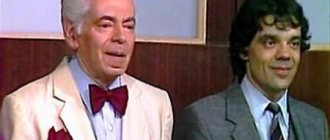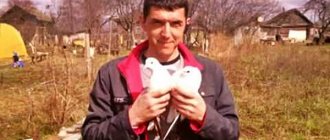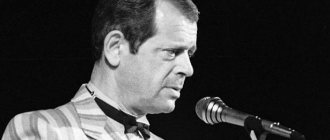Passion for theater: childhood and youth of Arkady Raikin
Arkady Raikin. Photo: photochronograph.ru
Arkady Raikin was born in Riga, in the family of a midwife and a scaffold scraper. He was the first child, later he had sisters Bella and Sophia and brother Maxim.
Our relationship with my father was strange. If it weren’t for my mother’s hidden, almost wordless resistance (she managed to shield us without contradicting him), it would not have been fun at all. Suffice it to say that our family did not have the habit of celebrating children's birthdays. We had almost no toys. We were not photographed (it was considered an expensive pleasure). However, as I realized later, it did not always depend on my father. During the time of the Civil War and military communism (and this was also my childhood), he was forced to answer the childish “I want” with “I want.” Be that as it may, we were accustomed to not asking for anything and did not expect surprises.
From the book by Arkady Raikin “Without Makeup. Memories"
During the First World War, the family fled to the city of Rybinsk, Yaroslavl region. The father got a new job, and Arkady Raikin went to a Jewish religious elementary school. While studying, he studied in a drama club, and once attended a concert by Fyodor Chaliapin with his parents. Later, taking his younger sisters with him, he made his way to the performances himself. And at the age of nine he performed on stage for the first time - in a drama club.
In the summer of 1922, the Raikins moved to Petrograd to Rubinstein Street. The future artist continued to go to performances, often visited the Alexandrinsky Theater, studied in the school drama club and painted. At the age of 13, the boy became seriously ill: after a prolonged cold, he developed a sore throat, which caused complications in his heart. Raikin was diagnosed with rheumatism and rheumatic heart disease, which confined him to bed for nine months. After his illness, he literally learned to walk again.
Biography
During the Soviet period, a number of magnificent artists appeared on the stage, but the name of Arkady Raikin stands apart. The comedian turned out to be an outstanding master of humorous monologues, not afraid to boldly ridicule human vices, as well as a talented actor and director, and also founded one of the most famous theaters in Moscow - Satyricon.
Arkady was born in Riga in 1911. The artist’s father, Isaac Davidovich, was a port worker, and his mother, Elizaveta Borisovna, took care of the housework, since the family was quite large. In addition to Arkasha, the parents also had a son, Max, and two daughters, Bella and Sophia.
With the outbreak of World War I, the Raikins moved to Rybinsk and then settled in St. Petersburg. From an early age, Arkady found himself in love with the theater. As a 4-year-old boy, Arkasha staged his own performances with children in the yard, and in Northern Palmyra he became addicted to attending the Academic Drama Theater. To buy tickets, the boy secretly sold notebooks and textbooks, for which he was repeatedly beaten by his father.
Another hobby of the boy was drawing. In fine arts lessons, the boy amazed the teacher with both technique and depth of thought. For a long time Arkady could not decide which profession to choose - painter or actor. And although his parents were categorically opposed to the theater, the young man still preferred this path.
Arkady Raikin in his youth
When Raikin entered the directing and acting department at the Leningrad Institute of Performing Arts, a scandal broke out, and Arkady had to break with his family for a long time and leave home. After university, the artist ended up at the Working Youth Theater, later renamed the Lenin Komsomol Theater. Today St. Petersburg residents know this place as the theater-festival “Baltic House”.
Young master of pantomime
Arkady Raikin with his wife Ruth Ioffe. Photo: photochronograph.ru
Arkady Raikin with his wife Ruth Ioffe and children Konstantin and Ekaterina. Photo: photochronograph.ru
Arkady Raikin with his wife Ruth Ioffe. Photo: photochronograph.ru
After school, Raikin wanted to enter the Leningrad College of Performing Arts, which later became the Theater Institute, but for this he needed to have a year of work experience. In 1929, he got a job as a laboratory assistant at the Okhta Chemical Plant, and the next year he was accepted into the technical school. Parents were against this decision, and Raikin left home for the hostel.
Artists, he [the father] believed, were mostly tramps, tumbleweeds. They are frivolous, unsuitable for life and therefore, with rare exceptions, are penniless and lack a stable position in society. Being a doctor, a lawyer, or, ultimately, a forest harvester is business, but being an artist is not business.
From the book by Arkady Raikin “Without Makeup. Memories"
Arkady Raikin entered the directing and acting course of theater director Vladimir Solovyov, who worked with Vsevolod Meyerhold in the 1910s.
At the same time, Raikin became interested in pantomime. There was no special course at the institute - only biomechanics with elements of pantomime, taught by Meyerhold's eldest daughter Irina. Raikin began taking private lessons in stage movement from the best eccentric mime of the Silver Age - composer and chansonnier Mikhail Savoyarov. Solovyov also supported the aspiring actor’s passion. The sketch with an imaginary cat, which Raikin prepared in his first year, immediately migrated to the repertoire of the House of Arts, where students performed. The very next year, Vladimir Solovyov gave Raikin the role of the deaf-mute servant Vespone in the play “The Maid and Mistress” based on the opera by Italian composer Giovanni Pergolesi, based entirely on pantomime. For three whole seasons, the performance was a resounding success, and this experience was useful to Raikin in his diploma work. He played the role of Mascarille's roguish servant in Molière's "Funny Primroses."
Raikin's student years also gave him happiness in his personal life. In 1934, he met Ruth Joffe, also an artist. A year later they got married.
In my last year, I once came to the student cafeteria and stood in line. I turned around and saw that she was standing behind me. She spoke first, and I remember this conversation verbatim. “Are you studying here? How wonderful it is! - “Yes, I’m studying... What are you doing tonight?” - “Nothing...” - “Shall we go to the cinema?” When we entered the cinema hall, took our seats and the lights went out, I immediately told her: “Marry me...”
From the memoirs of Arkady Raikin
Personal life
A very interesting story is the acquaintance of Arkady Raikin with his only wife Ruth Markovna Ioffe, whom he affectionately called Roma. Arkady first saw her as a boy, when he performed at a school amateur concert. Later I met the girl again on the street, but again did not dare to meet her. And only many years later, when Arkady was already graduating from university, the young people once again bumped into each other in the student canteen and agreed to go to the cinema. After the session, Raikin proposed to his Roma.
Ruth Ioffe and Arkady Raikin
The lovers got married in 1935, and soon a daughter, Ekaterina, appeared in the family, who would be the wife of three famous actors - Mikhail Derzhavin, Yuri Yakovlev and Vladimir Koval. And the son of Arkady and Ruth, Konstantin Raikin, himself became a famous artist and runs his own father’s brainchild, the Satyricon Theater.
Arkady Raikin with his wife and children
Arkady Isaakovich lived in perfect harmony with his wife for almost 50 years. The relationship between the actor and his wife became an example both for their own children and for everyone who knew this wonderful couple.
Soviet Charlie Chaplin
Arkady Raikin. Photo: photochronograph.ru
Arkady Raikin. Photo: photochronograph.ru
Arkady Raikin. Photo: photochronograph.ru
In 1935, Arkady Raikin graduated from the College of Performing Arts and was assigned to the Leningrad Working Youth Theater. But he soon moved to the future Lensovet, then the New Theater. In 1938, he acted as an entertainer: he replaced a sick artist in the Leningrad Recreation Garden. Young Raikin was also attracted to cinema. He starred in two films - “Years of Fire” by Vladimir Korsh-Sablin and “Doctor Kalyuzhny” by Erast Garin. Both films were released in 1939, but were not particularly successful.
Arkady Raikin completely focused on the stage. He constantly performed in cultural centers, palaces of pioneers, and hosted conferences. By 1939, the artist had two original dance and mimic numbers - “Chaplin” and “Bear”. He demonstrated them at the First All-Union Competition of Variety Artists in Moscow and earned the first recognition from the audience and the title of laureate of the second prize of the competition. Almost immediately, Raikin was invited to the troupe of the new Leningrad Variety and Miniature Theater, and three years later the artist became its director.
The banquet on the occasion of Stalin's 60th birthday in 1939 was held in the St. George Hall of the Grand Kremlin Palace... I was seated at a table directly opposite Stalin. The only plot that I had to show was agreed upon in advance. Encouraged by the look of the hero of the day, I stood up, pushed back my chair and portrayed one of my characters. Stalin laughed and applauded enthusiastically. Then he stood up, and everyone who was at the table also stood up. Stalin proposed a toast to Raikin, and everyone drank. Here I go and say: “Comrade Stalin, I can show you other types.” He seemed surprised, but nodded. The guests sat down, and I began to show them number by number. After each new story, Stalin stood up, and the guests also clapped their hands while standing. And so fourteen times.
From the memoirs of Arkady Raikin
During the Great Patriotic War, Raikin composed satirical miniatures. The team of his theater performed for soldiers at field airfields, artillery positions, and the decks of warships, for which in 1945 the artist was awarded the Order of the Patriotic War, Second Class.
Head of the Leningrad Variety and Miniature Theater, laureate of the All-Russian Variety Artists Competition, Comrade. Raikin culturally served the personnel of the ships of the Black Sea Fleet squadron, the Novorossiysk, Tuapse and Poti naval bases, served formations and units of the Black Sea Fleet Air Force...
From the award list
Awards and titles
- 1945 - Order of the Patriotic War, II degree
- 1947 - Honored Artist of the RSFSR
- 1957 - People's Artist of the RSFSR
- 1968 - People's Artist of the USSR
- 1971 - Order of the Red Banner of Labor
- 1980 - Lenin Prize
- 1981 - Hero of Socialist Labor
- 1981 - Order of Lenin
- 1985 - Order of the Patriotic War, 1st degree
- Order of Friendship of Peoples
- Medal "For the Defense of the Caucasus"
- Medal “In commemoration of the 100th anniversary of the birth of Vladimir
- Ilyich Lenin"
- Medal "For victory over Germany in the Great Patriotic War of 1941-1945"
Arkady Raikin Theater
Arkady Raikin. Photo: uznayvse.ru
Arkady Raikin. Photo: alekseykalugin.ru
Arkady Raikin. Photo: mytoot.ru
The public accepted Arkady Raikin's post-war performances on radio and television, as well as his roles in films, more than favorably. Viewers appreciated the artist’s talent in Mikhail Kalatozov’s film “Valery Chkalov” and Mikhail Slutsky’s film “Concert to the Front,” in which he starred during the war. Later, two more films with his participation were released - “We met somewhere” and “Concert of artists”.
Everything was going well at the Theater of Miniatures too. Together with the satirist Vladimir Polyakov, Raikin created new theater programs - “For a Cup of Tea”, “Don’t Pass By”, “Frankly ...” and the plays “Come, Let’s Talk”, “Love and Cunning”.
Raikin's theater, as a certain genre of pop art, is, first of all, no matter what they say, a theater of one central actor. At the same time, I do not want to offend his workmates, among whom there are many gifted, interesting artists, who with great skill create the necessary expressive background, a very complex gaming environment for Raikin. But there is no doubt that Raikin himself is a whole theater.
From a sketch by writer Lev Kassil
The theater of miniatures, directed by Arkady Raikin, was one of the most beloved among audiences of those years. Recognized artists of the era performed on its stage: Leonid Utesov, Klavdiya Shulzhenko, Alexander Menaker, Veniamin Nechaev, Eduard Khil, Maria Parkhomenko. Raikin also invited new stars, talented actors of the Parnas-2 youth theater from Odessa: Mikhail Zhvanetsky, Roman Kartsev, Viktor Ilchenko, Lyudmila Gvozdikova. By this time, Raikin was no longer working with the playwright Polyakov, but the theater still staged the plays “The Invisible Man,” “White Nights,” and “Love and Three Oranges.”
No one will say: “Today I’m going to a new performance at the Leningrad Theater of Miniatures.” Everyone will say: “I’m going to Raikin...”
From a review of the play “Love and Three Oranges” in Literaturnaya Gazeta, 1960s
In 1961, Raikin played Zhvanetsky’s first interlude, “A Conversation About.” Three years later, they together created a new theatrical program “Traffic Light”, where the satirist performed the famous miniatures “Avas”, “Scarcity”, “The Age of Technology”, “In the Greek Hall”.
Raikin's monologues were sharply satirical, but remained correct in relation to the authorities. Toughly, but intelligently, he ridiculed the vices of people and the “costs” of the political system: deficit, bureaucracy, cronyism. Despite the mercilessness of the images, Arkady Raikin’s feuilletons have always been liked by the public.
Movies
Over the years of his biography, Arkady has starred in dozens of films. For the first time on the big screen, he appeared in the film “The First Platoon” (1932), playing a soldier in it.
After that, Raikin played minor characters in such films as “Tractor Drivers”, “Valery Chkalov” and “Years of Fire”.
In 1954, Arkady was entrusted with the main role in the comedy “We Met Somewhere,” which was well received by Soviet viewers.
The paintings “Yesterday, Today and Always” and “The Magic Power of Art” received no less popularity.
However, Raikin gained the greatest fame after the premieres of the television plays “People and Mannequins” and “Peace to Your Home.” In them he presented many interesting and, as always, poignant monologues on the most pressing topics.
Death
Arkady Raikin was a sickly person almost all his life. At the age of 13, the future artist caught a severe cold at the skating rink, developing such a terrible sore throat that the doctors were sure that the boy would not survive. After 10 years, the disease returned, and again the doctors gave up. At that moment, I was lucky that my father-in-law insisted on an unpopular operation - removal of the tonsils. Raikin survived, but permanently developed rheumatic heart disease.
For the last three years, the actor suffered from Parkinson's disease, which limited his movements, facial expressions and even speech. Nevertheless, the artist visited his native theater at the first opportunity and handed over the business to his son, whom he loved very much.
Arkady Isaakovich Raikin died on December 17, 1987 from the consequences of rheumatic carditis. On December 20, the actor was buried at the Novodevichy cemetery, at the tenth site.
In 2002, the Leningrad Variety and Miniature Theater, whose artistic director Arkady Raikin worked for 40 years, was named after the artist. Since 2008, the popular pop and clownery artist Yuri Galtsev has become the artistic director of the Arkady Raikin Variety Theater. On the official website of the theatre, along with the poster and description of the theatre, there is also a biography of Arkady Raikin. The artist is called an era in the history of the theater.
Arkady Raikin's grave
Surprisingly, a monument to the legendary artist has not yet been erected either in Moscow or St. Petersburg, except for the monument with masks at the Novodevichy Cemetery. Although the capital authorities promised to correct this oversight back in 2020.
War and after
Concert to the front (1942)
Since the beginning of the Great Patriotic War, Raikin, his wife and the theater give many concerts at the front. They send their daughter to be evacuated to Central Asia, while they themselves work hard and focused. The hardships of the war also affected the actors; sometimes they were saved by a miracle. Once, the theater was touring in Dnepropetrovsk, when the front line was several tens of kilometers away. Having received information about this, the then secretary of the city committee, Leonid Brezhnev, practically forced the theater to evacuate, and after a couple of hours both the station and the railway were bombed by enemy aircraft.
During the war, Raikin also starred in several films, actively toured, and for this he would later be awarded the Order of the Great Patriotic War.
After the Victory, Arkady Isaakovich returned to his native Leningrad and continued to engage in his theater. Along the way, he starred in several humorous films, which instantly became box office leaders. It is here that he appears in various images, instantly changing both his character and appearance. It is here that the foundation of all modern techniques of Russian satire and humor is laid - the ability to bypass censorship, talk about the forbidden in other words, and so that the viewer understands everything, working with props and scenery.
Naturally, the theater instantly becomes popular. He tours the country, where Raikin not only performs himself, but also selects talent. For example, after a tour in Odessa, he brings with him then unknown Mikhail Zhvanetsky, Roman Kartsev and Viktor Ilchenko. Why don’t you like the current “Open Mic” and other shows?
The artist's fame goes beyond the USSR, and in 1965 he was invited to London. At the same time, for ideological reasons, they did not want to release it. Then the British simply paid the fee required by the Soviet side. Thus, Raikin at that time became the most expensive artist in the world. It goes without saying that he did not get a penny from this money. But in London he met his cousin, South African pianist Bruno Raikin.











